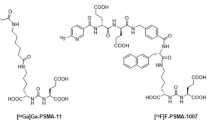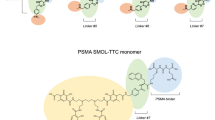Abstract
Purpose
This manuscript utilised in vivo multispectral imaging to demonstrate the efficacy of two different nanomedicine formulations for targeting prostate cancer.
Methods
Pegylated hyperbranched polymers were labelled with fluorescent markers and targeting ligands against two different prostate cancer markers; prostate specific membrane antigen (PSMA) and the protein kinase, EphrinA2 receptor (EphA2). The PSMA targeted nanomedicine utilised a small molecule glutamate urea inhibitor of the protein, while the EphA2 targeted nanomedicine was conjugated to a single-chain variable fragment based on the antibody 4B3 that has shown high affinity to the receptor.
Results
Hyperbranched polymers were synthesised bearing the different targeting ligands. In the case of the EphA2-targeting nanomedicine, significant in vitro uptake was observed in PC3 prostate cancer cells that overexpress the receptor, while low uptake was observed in LNCaP cells (that have minimal expression of this receptor). Conversely, the PSMA-targeted nanomedicine showed high uptake in LNCaP cells, with only minor uptake in the PC3 cells. In a dual-tumour xenograft mouse model, the nanomedicines showed high uptake in tumours in which the receptor was overexpressed, with only minimal non-specific accumulation in the low-expression tumours.
Conclusions
This work highlighted the importance of clearly defining the target of interest in next-generation nanomedicines, and suggests that dual-targeting in such nanomedicines may be a means to achieve greater efficacy.







Similar content being viewed by others
Abbreviations
- DCM:
-
Dichloromethane
- EGFR:
-
Epidermal growth factor receptor
- EphA2:
-
EphrinA2
- EPR:
-
Enhanced permeability and retention (effect)
- HBP:
-
Hyperbranched polymer
- HER2:
-
Human epidermal growth factor receptor 2
- NMR:
-
Nuclear magnetic resonance
- PAGE:
-
Polyacrylamide gel electrophoresis
- PBS:
-
Phosphate buffered saline
- PSMA:
-
Prostate-specific membrane antigen
- scFv:
-
Single chain variable fragment (of antibody)
- SEC-MALS:
-
Size exclusion chromatography – multiangle laser light scattering
- THF:
-
Tetrahydrofuran
- VEGF:
-
Vascular endothelial growth factor
References
Ross JF, Chaudhuri PK, Ratnam M. Differential regulation of folate receptor isoforms in normal and malignant tissues in vivo and in established cell lines. Physiologic and clinical implications. Cancer. 1994;73(9):2432–43.
Parker N, Turk MJ, Westrick E, Lewis JD, Low PS, Leamon CP. Folate receptor expression in carcinomas and normal tissues determined by a quantitative radioligand binding assay. Anal Biochem. 2005;338(2):284–93.
Andre S, Kojima S, Yamazaki N, Fink C, Kaltner H, Kayser K, et al. Galectins-1 and −3 and their ligands in tumor biology. Non-uniform properties in cell-surface presentation and modulation of adhesion to matrix glycoproteins for various tumor cell lines, in biodistribution of free and liposome-bound galectins and in their expression by breast and colorectal carcinomas with/without metastatic propensity. J Cancer Res Clin Oncol. 1999;125(8–9):461–74.
Wright GL, Haley C, Beckett ML, Schellhammer PF. Expression of prostate-specific membrane antigen in normal, benign, and malignant prostate tissues. Urol Oncol Semin Orig Investig. 1995;1(1):18–28.
Zhong Y, Meng F, Deng C, Zhong Z. Ligand-directed active tumor-targeting polymeric nanoparticles for cancer chemotherapy. Biomacromolecules. 2014;15(6):1955–69.
Bazak R, Houri M, El Achy S, Kamel S, Refaat T. Cancer active targeting by nanoparticles: a comprehensive review of literature. J Cancer Res Clin Oncol. 2015;141(5):769–84.
Byrne JD, Betancourt T, Brannon-Peppas L. Active targeting schemes for nanoparticle systems in cancer therapeutics. Adv Drug Deliv Rev. 2008;60(15):1615–26.
Weitman SD, Lark RH, Coney LR, Fort DW, Frasca V, Zurawski Jr VR, et al. Distribution of the folate receptor GP38 in normal and malignant cell lines and tissues. Cancer Res. 1992;52(12):3396–401.
Wang S, Low PS. Folate-mediated targeting of antineoplastic drugs, imaging agents, and nucleic acids to cancer cells. J Control Release Off J Control Release Soc. 1998;53(1–3):39–48.
Scarano W, Duong HT, Lu H, De Souza PL, Stenzel MH. Folate conjugation to polymeric micelles via boronic acid ester to deliver platinum drugs to ovarian cancer cell lines. Biomacromolecules. 2013;14(4):962–75.
Li L, Yang Q, Zhou Z, Zhong J, Huang Y. Doxorubicin-loaded, charge reversible, folate modified HPMA copolymer conjugates for active cancer cell targeting. Biomaterials. 2014;35(19):5171–87.
Ciardiello F, Tortora G. Epidermal growth factor receptor (EGFR) as a target in cancer therapy: understanding the role of receptor expression and other molecular determinants that could influence the response to anti-EGFR drugs. Eur J Cancer. 2003;39(10):1348–54.
Weiner LM, Surana R, Wang S. Monoclonal antibodies: versatile platforms for cancer immunotherapy. Nat Rev Immunol. 2010;10(5):317–27.
Gschwind A, Fischer OM, Ullrich A. The discovery of receptor tyrosine kinases: targets for cancer therapy. Nat Rev Cancer. 2004;4(5):361–70.
Ferrara N, Gerber H-P, LeCouter J. The biology of VEGF and its receptors. Nat Med. 2003;9(6):669–76.
Brannon-Peppas L, Blanchette JO. Nanoparticle and targeted systems for cancer therapy. Adv Drug Deliv Rev. 2012;64 Suppl 206–212.
Walker-Daniels J, Coffman K, Azimi M, Rhim JS, Bostwick DG, Snyder P, et al. Overexpression of the EphA2 tyrosine kinase in prostate cancer. Prostate. 1999;41(4):275–80.
Israeli RS, Powell CT, Corr JG, Fair WR, Heston WD. Expression of the prostate-specific membrane antigen. Cancer Res. 1994;54(7):1807–11.
Su SL, Huang IP, Fair WR, Powell CT, Heston WD. Alternatively spliced variants of prostate-specific membrane antigen RNA: ratio of expression as a potential measurement of progression. Cancer Res. 1995;55(7):1441–3.
Fuchs AV, Tse BWC, Pearce AK, Yeh M-C, Fletcher NL, Huang SS, et al. Evaluation of polymeric nanomedicines targeted to PSMA: effect of ligand on targeting efficiency. Biomacromolecules. 2015;16(10):3235–47.
Ghosh A, Wang X, Klein E, Heston WD. Novel role of prostate-specific membrane antigen in suppressing prostate cancer invasiveness. Cancer Res. 2005;65(3):727–31.
Pulukuri SM, Gondi CS, Lakka SS, Jutla A, Estes N, Gujrati M, et al. RNA interference-directed knockdown of urokinase plasminogen activator and urokinase plasminogen activator receptor inhibits prostate cancer cell invasion, survival, and tumorigenicity in vivo. J Biol Chem. 2005;280(43):36529–40.
Kullander K, Klein R. Mechanisms and functions of Eph and ephrin signalling. Nat Rev Mol Cell Biol. 2002;3(7):475–86.
Pasquale EB. Eph-Ephrin bidirectional signaling in physiology and disease. Cell. 2008;133(1):38–52.
Lindberg RA, Hunter T. cDNA cloning and characterization of eck, an epithelial cell receptor protein-tyrosine kinase in the eph/elk family of protein kinases. Mol Cell Biol. 1990;10(12):6316–24.
Riethmuller G, Schneider-Gadicke E, Johnson JP. Monoclonal antibodies in cancer therapy. Curr Opin Immunol. 1993;5(5):732–9.
Ogawa K, Pasqualini R, Lindberg RA, Kain R, Freeman AL, Pasquale EB. The ephrin-A1 ligand and its receptor, EphA2, are expressed during tumor neovascularization. Oncogene. 2000;19(52):6043–52.
Zelinski DP, Zantek ND, Stewart JC, Irizarry AR, Kinch MS. EphA2 overexpression causes tumorigenesis of mammary epithelial cells. Cancer Res. 2001;61(5):2301–6.
Chen P, Huang YAN, Zhang BO, Wang Q, Bai P. EphA2 enhances the proliferation and invasion ability of LNCaP prostate cancer cells. Oncol Lett. 2014;8(1):41–6.
Miao B, Ji Z, Tan L, Taylor M, Zhang J, Choi HG, et al. EPHA2 is a mediator of vemurafenib resistance and a novel therapeutic target in melanoma. Cancer Discov. 2015;5(3):274–87.
Brannan JM, Sen B, Saigal B, Prudkin L, Behrens C, Solis L, et al. EphA2 in the early pathogenesis and progression of non–small cell lung cancer. Cancer Prev Res. 2009;2(12):1039–49.
Brantley-Sieders DM. Clinical relevance of Ephs and ephrins in cancer: lessons from breast, colorectal, and lung cancer profiling. Semin Cell Dev Biol. 2012;23(1):102–8.
Murai KK, Pasquale EB. ‘Eph’ective signaling: forward, reverse and crosstalk. J Cell Sci. 2003;116(Pt 14):2823–32.
Taddei ML, Parri M, Angelucci A, Bianchini F, Marconi C, Giannoni E, et al. EphA2 induces metastatic growth regulating amoeboid motility and clonogenic potential in prostate carcinoma cells. Mol Cancer Res MCR. 2011;9(2):149–60.
Landen Jr CN, Lu C, Han LY, Coffman KT, Bruckheimer E, Halder J, et al. Efficacy and antivascular effects of EphA2 reduction with an agonistic antibody in ovarian cancer. J Natl Cancer Inst. 2006;98(21):1558–70.
Carles-Kinch K, Kilpatrick KE, Stewart JC, Kinch MS. Antibody targeting of the EphA2 tyrosine kinase inhibits malignant cell behavior. Cancer Res. 2002;62(10):2840–7.
Wu B, Wang S, De SK, Barile E, Quinn BA, Zharkikh I, et al. Design and characterization of novel EphA2 agonists for targeted delivery of chemotherapy to cancer cells. Chem Biol. 2015;22(7):876–87.
Noberini R, Koolpe M, Peddibhotla S, Dahl R, Su Y, Cosford NDP, et al. Small molecules can selectively inhibit Ephrin binding to the EphA4 and EphA2 receptors. J Biol Chem. 2008;283(43):29461–72.
Hammond SA, Lutterbuese R, Roff S, Lutterbuese P, Schlereth B, Bruckheimer E, et al. Selective targeting and potent control of tumor growth using an EphA2/CD3-Bispecific single-chain antibody construct. Cancer Res. 2007;67(8):3927–35.
Presta LG. Engineering of therapeutic antibodies to minimize immunogenicity and optimize function. Adv Drug Deliv Rev. 2006;58(5–6):640–56.
Marcucci F, Lefoulon F. Active targeting with particulate drug carriers in tumor therapy: fundamentals and recent progress. Drug Discov Today. 2004;9(5):219–28.
Pearce AK, Rolfe BE, Russell PJ, Tse BWC, Whittaker AK, Fuchs AV, et al. Development of a polymer theranostic for prostate cancer. Polym Chem. 2014;5(24):6932–42.
Coles DJ, Rolfe BE, Boase NRB, Veedu RN, Thurecht KJ. Aptamer-targeted hyperbranched polymers: towards greater specificity for tumours in vivo. Chem Commun. 2013;49(37):3836–8.
Liu B, Kazlauciunas A, Guthrie JT, Perrier S. One-pot hyperbranched polymer synthesis mediated by reversible addition fragmentation chain transfer (RAFT) polymerization. Macromolecules. 2005;38(6):2131–6.
Frechet JMJ, Henmi M, Gitsov I, Aoshima S, Leduc MR, Grubbs RB. Self-condensing vinyl polymerization: an approach to dendritic materials. Science. 1995;269(5227):1080–3.
Taddei ML, Parri M, Angelucci A, Onnis B, Bianchini F, Giannoni E, et al. Kinase-dependent and -independent roles of EphA2 in the regulation of prostate cancer invasion and metastasis. Am J Pathol. 2009;174(4):1492–503.
Chang SS, Reuter VE, Heston WDW, Bander NH, Grauer LS, Gaudin PB. Five different anti-prostate-specific membrane antigen (PSMA) antibodies confirm PSMA expression in tumor-associated neovasculature. Cancer Res. 1999;59(13):3192–8.
Tan JH, McMillan NAJ, Payne E, Alexander C, Heath F, Whittaker AK, et al. Hyperbranched polymers as delivery vectors for oligonucleotides. J Polym Sci A Polym Chem. 2012;50(13):2585–95.
Rolfe BE, Blakey I, Squires O, Peng H, Boase NRB, Alexander C, et al. Multimodal polymer nanoparticles with combined 19 F magnetic resonance and optical detection for tunable, targeted, multimodal imaging in vivo. J Am Chem Soc. 2014;136(6):2413–9.
Fang J, Nakamura H, Maeda H. The EPR effect: unique features of tumor blood vessels for drug delivery, factors involved, and limitations and augmentation of the effect. Adv Drug Deliv Rev. 2011;63(3):136–51.
Frangioni JV. In vivo near-infrared fluorescence imaging. Curr Opin Chem Biol. 2003;7(5):626–34.
Hansch A, Sauner D, Hilger I, Bottcher J, Malich A, Frey O, et al. Autofluorescence spectroscopy in whole organs with a mobile detector system. Acad Radiol. 2004;11(11):1229–36.
Boase NRB, Blakey I, Rolfe BE, Mardon K, Thurecht KJ. Synthesis of a multimodal molecular imaging probe based on a hyperbranched polymer architecture. Polym Chem. 2014;5(15):4450–8.
Bartlett DW, Su H, Hildebrandt IJ, Weber WA, Davis ME. Impact of tumor-specific targeting on the biodistribution and efficacy of siRNA nanoparticles measured by multimodality in vivo imaging. Proc Natl Acad Sci U S A. 2007;104(39):15549–54.
ACKNOWLEDGMENTS AND DISCLOSURES
The researchers would like to thank Dr Christopher Howard (Australian Institute for Bioengineering and Nanotechnology, Australia) for the LNCaP cells and EphA2 scFv used in this study. This work was performed in part at the Queensland node of the Australian National Fabrication Facility, a company established under the National Collaborative Research Infrastructure Strategy to provide nano- and micro-fabrication facilities for Australia’s researchers. We acknowledge funding from the National Health and Medical Research Council (APP1099321, KJT), the Australian Research Council (FT110100284 (KJT), DP140100951 (KJT)), and the Australian Commonwealth Government Australian Postgraduate Award (AKP). This research was conducted and funded by the ARC Centre of Excellence in Convergent Bio-Nano Science and Technology (CE140100036).
Author information
Authors and Affiliations
Corresponding author
Rights and permissions
About this article
Cite this article
Pearce, A.K., Fuchs, A.V., Fletcher, N.L. et al. Targeting Nanomedicines to Prostate Cancer: Evaluation of Specificity of Ligands to Two Different Receptors In Vivo . Pharm Res 33, 2388–2399 (2016). https://doi.org/10.1007/s11095-016-1945-x
Received:
Accepted:
Published:
Issue Date:
DOI: https://doi.org/10.1007/s11095-016-1945-x




